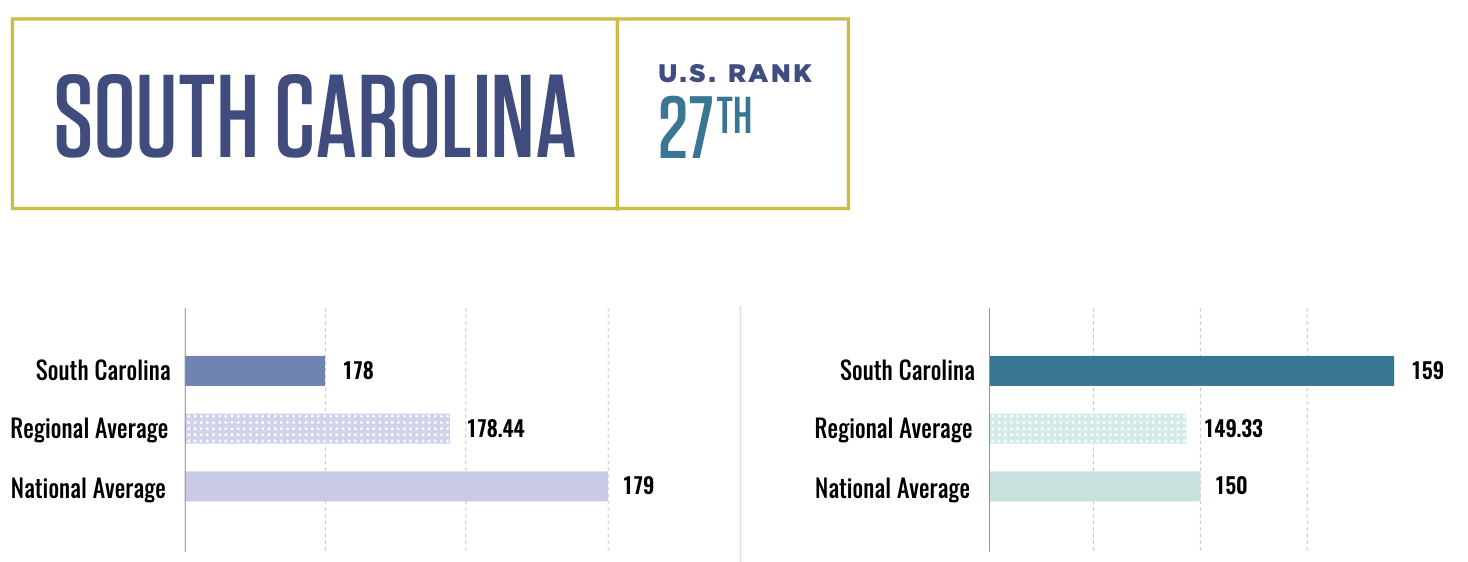
When Haircuts Meet Red Tape: Delhi’s Barbers Trapped in a Fee Frenzy
November 15, 2023
A Snapshot of Occupational Licensing in Idaho
November 20, 2023A Snapshot of Occupational Licensing in South Carolina
Edward Timmons1, Conor Norris1, and Noah Trudeau1,2
1: Knee Center for the Study of Occupational Regulation, West Virginia University
2: Troy University, Alabama
Occupational licensing makes it illegal to work in an occupation before meeting state-mandated entry requirements that often include minimum levels of education and training, paying fees to the state, and passing exams. Nationally, 21% of workers are licensed.[1]
Licensing requirements for the same profession vary significantly across states. The 2023 State Occupational Licensing Index (SOLI) ranks states by the number of occupations that are licensed.[2] The SOLI database focuses on 331 occupations that are available in the Knee Center licensing database.[3]
South Carolina’s SOLI ranking
In the 2023 SOLI, South Carolina ranks 27th nationally (with 1st being the most burdensome). South Carolina makes it illegal to work in 178 of the 331 occupations examined. This is 1 less occupation than the national average of 179, but more than 30 more than Kansas—the state with the fewest legal barriers (147) to working nationally.
Uniquely licensed occupations in South Carolina
Among the 178 occupations that South Carolina establishes minimum entry requirements to begin working, there are 24 occupations that are licensed in 20 states or fewer nationally. Table 1 provides a full list of these occupations and there is also a separate excel file with full details for interested readers.
South Carolina is one of only 2 states to issue a separate license for specialty residential contractors. South Carolina is also one of only 3 states to license subsurface sewage cleaners and one of 10 to license professional fighting referees.
Table 1: Uniquely licensed occupations in South Carolina
| Occupation | Total States |
| Specialty Residential Contractor | 2 |
| Subsurface Sewage Cleaner | 3 |
| Motor Vehicle Physical Damage Appraiser | 8 |
| Septic Tank Cleaner | 8 |
| Home Improvement Contractor | 9 |
| Professional Fighting Referee | 10 |
| Auctioneer Apprentice | 11 |
| Piping Contractor | 11 |
| Surgical Technologist | 11 |
| Public Accountant | 13 |
| Soil Tester/Classifier | 13 |
| Anesthesiologist Aide/Assistant | 14 |
| Professional Fighting Announcer | 14 |
| Forester | 15 |
| Gas Fitter | 15 |
| Geologist in Training | 15 |
| Medical Clinical Laboratory Technician | 15 |
| Professional Boxer/Wrestler/Fighter Trainer | 15 |
| Professional Wrestler | 15 |
| Paraprofessional/Teacher’s Aide | 16 |
| Milk Weigher/Sampler | 16 |
| Investment Advisor | 17 |
| Pyrotechnic Operator | 17 |
| Optician Apprentice/Trainee | 18 |
Sources: State Occupational Licensing Index 2023 Master File and Knee Center Occupational Licensing Database.
Why Licensing Reform is Important
By making it illegal to work in 178 occupations, and uniquely licensing at least 24 occupations, South Carolina is imposing significant cost on its citizens.
Existing economic research suggests that occupational licensing raises prices by as much as 16%.[4] Licensing also reduces employment by as much as 27% by making it more difficult to begin working in licensed professions.[5] Nationally, it is estimated that occupational licensing results in 2 million fewer jobs being created each year.[6]
Although licensing may have historically resulted in some benefits to consumers[7], there is little evidence that it is helping consumers in the present. Recent work finds little evidence that occupational licensing is improving the quality of services provided to consumers in the US and Europe.[8]
In summary, South Carolina currently places unique restrictions on its citizens to begin working. These restrictions are very costly and generate little to no measurable benefits for consumers. Following the lead of the majority of other states and choosing less restrictive ways to regulate and protect consumers would be in the best interest of South Carolina citizens.
[1] Data on certifications and licenses (CPS), Bureau of Labor Statistics, https://www.bls.gov/cps/certifications-and-licenses.htm, January 25, 2023.
[2] Noah Trudeau and Edward Timmons. State Occupational Licensing Index 2023. Archbridge Institute, https://www.archbridgeinstitute.org/state-occupational-licensing-index-2023/, March 20, 2023.
[3] https://csorwvu.com/
[4] President Obama White House, Occupational Licensing: A Framework for Policymakers, https://obamawhitehouse.archives.gov/sites/default/files/docs/licensing_report_final_nonembargo.pdf, July 2015.
[5] Peter Blair and Bobby Chung, (2019), How Much of Barrier to Entry is Occupational Licensing?. British Journal of Industrial Relations, 57: 919-943
[6] Evgeny Vorotnikov and Morris Kleiner, (2018), At What Cost? State and National Estimates of the Economic Costs of Occupational Licensing., Institute for Justice, https://ij.org/report/at-what-cost/#:~:text=By%20a%20conservative%20measure%20of,reach%20%24184%20billion%20or%20more.
[7] D. Mark Anderson, Ryan Brown, Kerwin Kofi Charles, and Daniel I. Rees, (2020), Occupational Licensing and Maternal Health: Evidence from Early Midwifery Laws., Journal of Political Economy, 128(11): 4337-4383.
[8] Morris Kleiner and Maria Koumenta (Eds.). (2022). Grease or grit? International case studies of occupational licensing and its effects on efficiency and quality. Kalamazoo, MI: W.E. Upjohn Institute for Employment Research.



